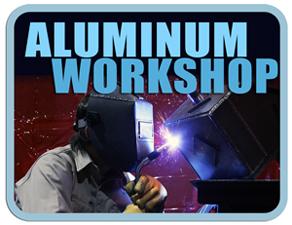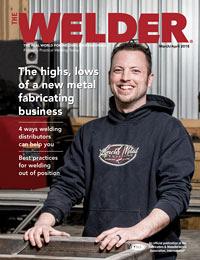President
- FMA
- The Fabricator
- FABTECH
- Canadian Metalworking
Categories
- Additive Manufacturing
- Aluminum Welding
- Arc Welding
- Assembly and Joining
- Automation and Robotics
- Bending and Forming
- Consumables
- Cutting and Weld Prep
- Electric Vehicles
- En Español
- Finishing
- Hydroforming
- Laser Cutting
- Laser Welding
- Machining
- Manufacturing Software
- Materials Handling
- Metals/Materials
- Oxyfuel Cutting
- Plasma Cutting
- Power Tools
- Punching and Other Holemaking
- Roll Forming
- Safety
- Sawing
- Shearing
- Shop Management
- Testing and Measuring
- Tube and Pipe Fabrication
- Tube and Pipe Production
- Waterjet Cutting
Industry Directory
Webcasts
Podcasts
FAB 40
Advertise
Subscribe
Account Login
Search
Aluminum Workshop: Still experiencing porosity? Explore these uncommon causes
- By Frank Armao
- March 15, 2018
- Article
- Aluminum Welding
In the past couple of columns we discussed the most common causes of weld porosity in aluminum. Hopefully, you all remember them. Just in case you don’t, they are:
- Insufficient preweld cleaning. You must remove all oils, greases, lubricants, and so forth from the weld area before you weld.
- Airflow in the weld area. If air is moving fast enough for you to feel, that is too much. Close all doors and windows and turn off all fans within the weld area.
- Gas-nozzle-to-work distance that is too long. Keep it as short as possible.
What if you are certain you’ve got these variables under control but you still have porosity? What now? Take a look at the following potential causes of porosity that are not as commonplace, but do still occur.
- Leaky water-cooled welding gun. Leaks can occur with a gun that is worn out. More often leaks occur because the gun has been dropped or otherwise abused. Don’t assume that the gun is leaktight just because you don’t see water dripping out the end. Even a leak too small for you to notice will cause porosity. To be sure, consider using a different gun.
- Poor shielding gas quality. It is possible for the argon shielding gas to contain water or other contaminants. It doesn’t happen often because the major gas suppliers are very strict about gas quality. However, try a different bottle of gas just to be sure.
- Surface contaminants on the welding wire. Aluminum wire must be lubricated during the manufacturing process, or it will break during drawing. It is up to the wire manufacturer to be sure that all of this lubricant is removed before it is spooled. Like gas suppliers, all of the major wire manufacturers do a really good job of this. If you are experiencing porosity, try changing the wire spool to rule out the possibility of a bad spool of wire.
- Oil and/or water in the shop air supply. Almost all shop air supplies contain oil and/or water residue. If it gets onto the weld area, it can cause porosity. Make sure there is a good filter on the shop air supply near the weld area. Also, be careful about what direction the exhaust from air tools is pointed. I once was in a good shop that was having porosity problems. The fabricator was using a pneumatically powered wire brush to clean the weld between passes. The problem turned out to be that the air tool exhaust was directed right into the weld groove. Since the shop air contained a lot of water and oil, the tool wasn’t cleaning the weld; it was contaminating it.
- Gas fittings in poor condition. Be sure that all gas fittings are tight and that gas hoses have no cracks or splits in them.
- Water leaks caused by improper equipment, setup. If you are using a water-cooled gun, be sure to use a water cooler. Never run the water supply to the gun directly from a city water outlet and then to a drain. Why? Because in warm weather the water will be colder than it is when using a recirculating water cooler, which can cause damp, humid air to condense inside the gun hoses, resulting in a water leak.
About the Author

Frank Armao
Aluminum Consulting Inc.
440-479-0239
About the Publication
subscribe now

The Welder, formerly known as Practical Welding Today, is a showcase of the real people who make the products we use and work with every day. This magazine has served the welding community in North America well for more than 20 years.
start your free subscription- Stay connected from anywhere

Easily access valuable industry resources now with full access to the digital edition of The Fabricator.

Easily access valuable industry resources now with full access to the digital edition of The Welder.

Easily access valuable industry resources now with full access to the digital edition of The Tube and Pipe Journal.
- Podcasting
- Podcast:
- The Fabricator Podcast
- Published:
- 04/16/2024
- Running Time:
- 63:29
In this episode of The Fabricator Podcast, Caleb Chamberlain, co-founder and CEO of OSH Cut, discusses his company’s...
- Trending Articles
Sheffield Forgemasters makes global leap in welding technology

ESAB unveils Texas facility renovation

Engine-driven welding machines include integrated air compressors

How welders can stay safe during grinding

The impact of sine and square waves in aluminum AC welding, Part I

- Industry Events
16th Annual Safety Conference
- April 30 - May 1, 2024
- Elgin,
Pipe and Tube Conference
- May 21 - 22, 2024
- Omaha, NE
World-Class Roll Forming Workshop
- June 5 - 6, 2024
- Louisville, KY
Advanced Laser Application Workshop
- June 25 - 27, 2024
- Novi, MI



























